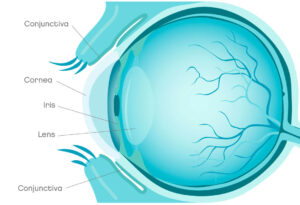Conjunctivitis is an eye condition usually caused by infection or allergies. Occasionally, it can resolve itself, but most cases need medication. Dogs of any age or breed can develop conjunctivitis.
Conjunctivitis or “pink eye” is one of the most common causes of red, inflamed eyes in dogs. It occurs when the conjunctiva is inflamed or infected. Unlike people, most forms are non-contagious, but there are some infectious forms that dogs can spread to each other. It’s recommended that you speak to a vet to see if your dog needs medical treatment.
Overview
What is conjunctivitis in dogs?
Conjunctivitis is simply redness and inflammation of the conjunctiva.
The conjunctiva is the tissue that covers the inner surface of the eyelids and the white part of the eye (sclera).
Both eyes are usually affected, but it can affect just one.
It’s mainly caused by bacterial infections and allergies.

Allergic conjunctivitis is used to describe inflammation of the eye that’s caused by environmental allergens like pollen, mould, and dust.
Other causes of conjunctivitis in dogs:
- Foreign objects, such as grass seeds
- Dry eye
- Cherry eye
- Eye ulcers
- Trauma
- Defects of the eyelid or eyelashes
- Tear duct diseases
- Tumours of the eye or eyelid
- Systemic diseases
- Glaucoma (a disease that increases the pressure inside of the eye)
- Uveitis (inflammation of the middle layer of the eye)
- Viral infection
- Environmental irritation (dust, smoke, chemicals, air fresheners)
If left untreated conjunctivitis can become harder to treat and lead to severe eye issues.


Symptoms
Symptoms of conjunctivitis in dogs
- Eye discharge (yellow, green, or clear)
- Pink or red eye
- Pawing or rubbing at the face
- Blinking more than usual or squinting
- Swelling of the tissue that lines the eyelids and surface of the eye (conjunctiva)
Risk
Are some dogs more at risk of conjunctivitis than others?
Any breed or age of dog can develop conjunctivitis.
Certain breeds are more likely to get conjunctivitis if they have certain genetic conditions such as allergic conjunctivitis, dry eye, or cherry eye.
Some of these breeds include Shar-Pei, English and French Bulldogs, Shih Tzu, Great Dane, Cavalier King Charles Spaniel and Hounds.
Is conjunctivitis in dogs contagious to humans?
Even though it’s very unlikely you will get conjunctivitis from your dog, you should always wash your hands after applying medications or touching your dog’s face during treatment.
Diagnosis
How is conjunctivitis diagnosed in dogs?
Vets may need to use various tests to help find out the cause of the conjunctivitis:
- Visual examination
- Dye test
- Tear production test
- Test the pressure inside the eye
Vets will sometimes take eye samples for special tests to send to a lab. This may include:
- Bacterial culture and sensitivity testing
- Testing for viruses
- Blood tests to check for other illnesses affecting the body and the eyes
Depending on your dog’s temperament, your vet may need to sedate them to check their eye, especially if a foreign body is suspected.
Vet treatment
What are some of the treatment options for conjunctivitis in dogs?
The course of this medical problem depends on the underlying condition. In most cases, it can be easily resolved.
Vets prescribe different treatments depending on what’s causing the conjunctivitis. Treatments include:
General treatment for mild conjunctivitis:
- Eye cleaners: washes, wipes, gels
- Lubricating, soothing treatment: gels, ointments
Prescription medicines depend on the underlying cause:
- Antibiotics: gels, ointments, drops for the eye, oral medication
- Steroid anti-inflammatory: drops, ointment, oral tablets
Other treatments or surgery may be necessary to treat the underlying cause of conjunctivitis. Cherry eye or glaucoma are two examples.
Home treatment
Things you can do at home to ease the symptoms of conjunctivitis in your dog
Use sterile saline to flush the eye.
- Use a cotton ball soaked in saline to flush a few drops into the eye 2-4 times daily.
- Clean any accumulated discharge around the eye using a cotton pad.
- Sterile saline is available in pharmacies. Make your own at home with cooled-down boiled water.
Use a buster collar on your dog: preventing damage to the eye is important, as pets may scratch at their eyes with their paws or rub their face on furniture.
Don’t use human medications for your dog without speaking to a vet first.
When to worry
When do you need to call a vet if your dog has conjunctivitis?
If your dog shows any of the following signs call your vet:
- Squinting or inability to hold the eye(s) open
- Signs of pain, including pawing at the face
- Signs of systemic illness, including coughing, tiredness, decreased appetite, vomiting, or diarrhoea
- Failure to improve despite treatment
Call us at Joii if your dog has any of the following:
- Runny or red eye
- Pawing or scratching around their eyes
- Swollen eye or face
- If you’re not sure, it’s best to be safe








